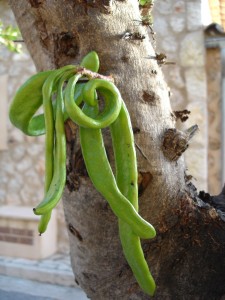Ceratonia siliqua

One of the interesting and unusual features of the carob tree is a habit known as cauliflory, where the flowers and seed pods can grow straight out of the trunk.
If you’ve ever been on holiday to the Mediterranean then you’ve almost certainly seen the carob tree. It’s not as widely planted as the ubiquitous olive; but it’s often there growing among them: a large gnarled tree with long brown pods in the summer and a curious scent when flowering. It provides useful shade and the pods have some value as a chocolate substitute (although a poor one in my view) and as a thickening agent.
A weighty problem
The seeds of the carob have made it famous, although as the tree is dioecious, you only find seeds on female trees. It is popularly believed that the carat, the unit of weight for gemstones, is derived from the name of the carob tree via an ancient weighing system. For example, the ancient Greeks had a small weight, the kerat, while the siliqua (from the Latin for carob, siliqua Graeca) is the smallest subdivision of the Roman pound. Incidentally, the measure of gold purity—also called the carat (UK English) or karat (US English)—derives from the time of the Emperor Constantine when a new gold coin was struck at 72 to the Roman pound, meaning that each coin weighed 24 siliquae or carats. According to the Oxford English Dictionary the word carat first appeared in 1555 but its weight varied from place to place prior to its standardization at 200 mg in 1907.
Carob was reputedly selected because the mass of its seeds is unusually constant. We tested this idea by weighing lots of seeds from different trees that were growing in a common garden on Mallorca1. We then compared the variability in carob seed weights with that found in other species. It turns out that carob is actually pretty average, which begs the question, why did ancient traders rely on its seeds for their high-value dealing?
Human selection?
A second thing we tried was to ask people to look at two seeds and tell us which was heavier. People proved remarkably good at this, and could spot differences as small as 5%. We think that this human selection probably led to traders carefully selecting seeds that were close to the average weight. If they really used the seeds, then there would have been inevitable tension between buyer and seller: one preferring larger seeds and one preferring smaller ones. It’s certainly interesting that the official weight of the carat is very close to the average mass of the seeds, suggesting that over time these forces cancelled each other out. Perhaps each trader even carried their own seeds and they then argued over which ones to use, gradually discarding ones that were clearly too small or too large.
It’s certainly fascinating to think of ancient people sitting under a carob tree, sifting through its seeds, and trading diamonds or other precious stones. Amazingly, the marks of diamond drills have been found on Roman antiquities2 and even on beads in Yemen dated to the fourth century BC3 , raising the possibility of a truly ancient association between diamond and carob.
- Turnbull, L. A., et al. (2006) Seed size variability: from carob to carats. Biology Letters 2, 397 – 400.
- Gorelick, L. & Gwinnett, A. J. 1988 Diamonds from India to Rome and beyond. Am. J Archaeol. 92, 547–552.
- Gwinnett, A. J. & Gorelick, L. 1991 Bead manufacture at Hajar Ar-Rayhani, Yemen. The Bib. Archaeol. 54, 186–196.
